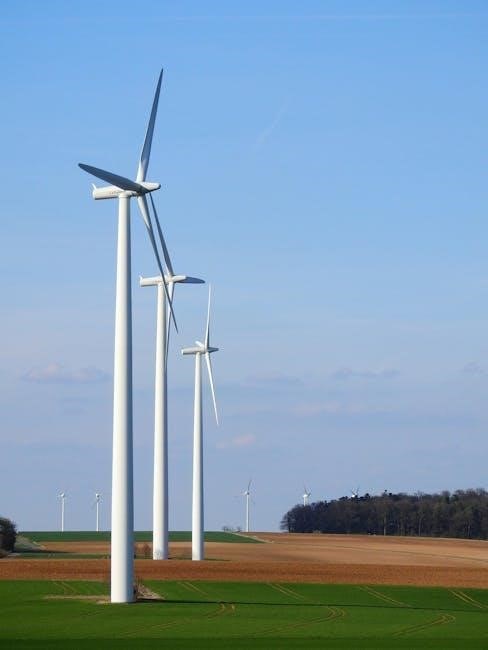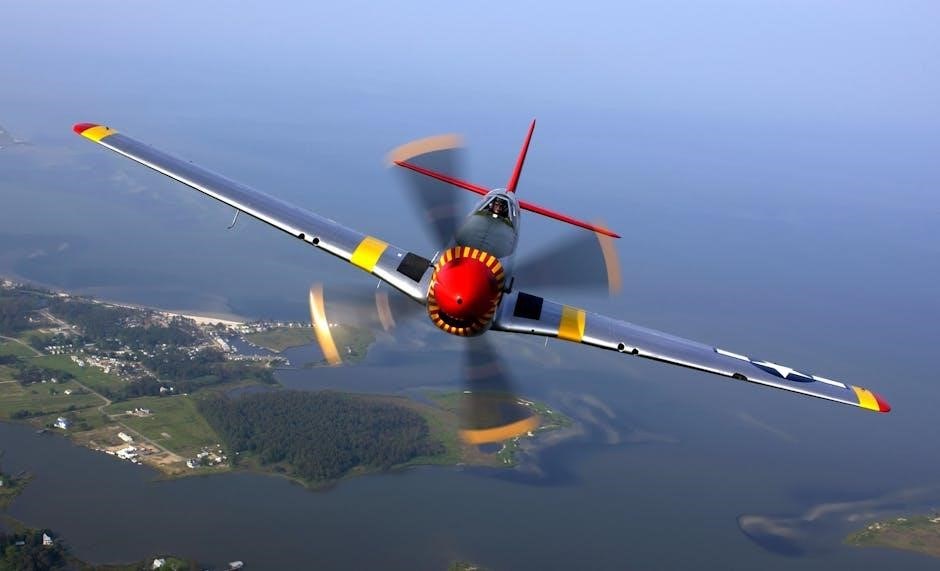Understanding Yamaha Propellers
This section offers a detailed introduction to Yamaha outboard propellers, covering fundamental aspects that impact their performance. We will explore key factors to consider for optimal propeller selection, ensuring a better boating experience.
Propeller Basics: Diameter and Pitch
Understanding propeller basics is crucial for choosing the right Yamaha propeller. Two key parameters are diameter and pitch. The diameter refers to the breadth of the circular path traced by the propeller during rotation. It’s measured in inches and affects the propeller’s ability to move water. A larger diameter generally provides more thrust, beneficial for heavier boats or those needing strong acceleration. Conversely, a smaller diameter might be suitable for lighter boats prioritizing speed.
Pitch, also measured in inches, indicates the theoretical distance a propeller travels forward in one revolution. A higher pitch means greater theoretical distance, potentially leading to higher top speeds. However, it also requires more engine power to turn. A lower pitch offers quicker acceleration and better performance at lower speeds, making it suitable for towing or navigating in choppy waters. Selecting the correct combination of diameter and pitch is vital for matching the propeller to your boat’s specific needs and engine capabilities, thus optimizing overall performance and efficiency.
Factors Affecting Propeller Selection
Selecting the right Yamaha propeller involves considering several crucial factors beyond just diameter and pitch. The type of boat, its weight, and the engine’s horsepower are significant determinants. Heavier boats generally require propellers with larger diameters and lower pitches to provide adequate thrust for acceleration and maneuverability. Conversely, lighter boats may benefit from propellers with smaller diameters and higher pitches, allowing for increased top speeds.
The intended use of the boat also plays a vital role. If the boat is primarily used for watersports like towing skiers or wakeboarders, a propeller with a lower pitch is preferable for its enhanced low-end torque. For recreational boating or fishing, a propeller that balances speed and fuel efficiency is often the best choice. Furthermore, consider the typical operating conditions. In choppy waters, a propeller designed for better grip and control is essential. Careful consideration of these factors ensures optimal propeller selection, maximizing performance and enjoyment on the water.

Yamaha Propeller Selection Guide
This guide simplifies choosing the perfect Yamaha propeller. Navigate our resources to match your boat and engine for enhanced performance. Maximize your boating experience.
Using Yamaha’s Online Prop Selector
Yamaha’s online prop selector tool simplifies finding the ideal propeller for your boat and outboard. This tool requires you to gather essential information about your boat, outboard engine(s), and current propeller specifications. Furthermore, you will need to determine your desired performance goals, such as top speed, fuel efficiency, or enhanced acceleration.
The process involves entering this data in a three-step sequence, where each step refines the input for more accurate recommendations. After each step, the tool presents propeller options tailored to the information you’ve provided. This iterative approach helps narrow down the choices, ensuring you select a propeller that optimally matches your specific needs and enhances your boating experience. This ensures proper engine loading and performance.
Gathering Necessary Information
Before selecting a Yamaha propeller, gathering precise information is crucial for optimal performance. Begin by documenting your boat’s specifications, including its length, weight, and hull type. Accurately identify your Yamaha outboard model, horsepower, and year of manufacture. Note the current propeller’s diameter, pitch, and model number, if available.
Consider your typical boating conditions and desired performance characteristics. Determine whether you prioritize top speed, fuel efficiency, acceleration, or load-carrying capacity. Assessing these factors will guide your propeller selection process. Also, collect data regarding the current propeller, the engine model, and the hull. The data collected will be entered into the Yamaha online prop selector to make an informed decision.
Understanding Propeller Size Markings
Yamaha propeller sizes are indicated by markings typically found on the propeller hub. These markings provide vital information about the propeller’s dimensions and characteristics. The markings usually consist of two numbers separated by an “x,” such as 13 x 19. The first number represents the propeller’s diameter in inches, indicating the size of the circle the propeller makes as it rotates.
The second number signifies the propeller’s pitch, also measured in inches. Pitch refers to the theoretical distance a propeller would advance in one revolution. Understanding these markings is essential for selecting a propeller that matches your boat’s engine and performance requirements. The size of the propeller can be found on the propeller boss end or on the side of the propeller boss.

Yamaha Propeller Series
Yamaha offers a diverse range of propeller series designed to suit various boating needs and engine types. These series differ in materials, blade design, and intended applications, which optimizes boat performance.
Overview of Available Series
Yamaha provides various propeller series, each engineered for specific performance characteristics. The “M” series, for example, caters to outboards ranging from 150 to 300 horsepower. These propellers are designed to deliver a balance of speed and fuel efficiency.
The Turbo series offers polished stainless steel propellers built for high performance across all Yamaha outboards; These are frequently chosen for their durability and ability to enhance acceleration.
For smaller boats and applications like flats, the stainless-steel, four-blade propeller offers an improved acceleration and load carrying ability.
Each series incorporates distinct design elements to optimize boat handling, speed, and overall efficiency. Selecting the appropriate series ensures your Yamaha outboard performs at its peak, perfectly aligned with your boating requirements and preferences. Understanding the nuances of each series is vital for any boater seeking to maximize their vessel’s potential.
Propeller Materials: Aluminum vs. Stainless Steel
Yamaha propellers are typically available in aluminum and stainless steel, each offering distinct advantages. Aluminum propellers are a cost-effective choice, suitable for general boating and recreational use. They provide adequate performance for everyday activities and are easier to repair.
Stainless steel propellers, on the other hand, offer enhanced durability and resistance to damage. Their strength allows for thinner blades, improving efficiency and top-end speed. Stainless steel props excel in demanding conditions and are ideal for high-performance boats.
While aluminum propellers are more affordable, stainless steel propellers offer a longer lifespan and superior performance. The choice depends on your boating needs, budget, and the type of activities you pursue; Consider the trade-offs between cost, durability, and performance when selecting the appropriate material for your Yamaha propeller.

Propeller Performance and Optimization
This section focuses on maximizing your boat’s performance through optimal propeller selection. We will discuss matching propellers to different engine and boat types, and testing your choice for the best results.
Matching Propeller to Engine and Boat Type
Selecting the ideal Yamaha propeller requires a keen understanding of how it interacts with your engine and boat. The goal is to find a harmonious balance that maximizes performance and efficiency. Consider the type of boat you have; a heavy cruiser demands a different propeller than a light, planing hull.
Engine horsepower is a crucial factor. A larger engine can handle a propeller with a higher pitch, translating to greater top-end speed. However, if the pitch is too high for the engine, it will struggle to reach its optimal RPM range, leading to poor acceleration and fuel economy.
For smaller boats and lower horsepower engines, a propeller with a lower pitch is often the better choice. This provides better acceleration and the ability to carry heavier loads, which is essential for activities like waterskiing or fishing with multiple passengers.
Remember that the propeller acts as a gearbox, translating engine power into thrust. By carefully matching the propeller to the engine and boat type, you can unlock your boat’s full potential.
Testing and Adjusting Propeller Choice
Once you’ve selected a propeller based on your boat and engine specifications, real-world testing is essential to fine-tune your choice. Begin by observing your engine’s RPM at wide-open throttle (WOT). Consult your Yamaha engine’s manual for the recommended WOT RPM range. If your engine fails to reach the lower end of this range, the propeller pitch is likely too high. Conversely, if your engine exceeds the upper limit, the pitch is too low.
Adjusting propeller pitch is key to optimizing performance. If the RPM is too low, switch to a propeller with a lower pitch to allow the engine to rev more freely. This will improve acceleration and responsiveness. If the RPM is too high, a higher pitch propeller will help you reach higher speeds without overworking the engine.
Besides RPM, also pay attention to your boat’s handling and fuel efficiency. Experiment with different propellers and carefully document the results. This iterative process of testing and adjustment will lead you to the perfect propeller for your needs, maximizing both performance and enjoyment on the water.

Propeller Maintenance
Proper maintenance is crucial for extending the life of your Yamaha propeller and ensuring optimal performance. Regular inspection and cleaning, along with proper storage techniques, are key to preventing damage.
Inspecting for Damage
Regular inspection of your Yamaha propeller is vital for maintaining peak performance and preventing costly repairs. Carefully examine the blades for any signs of damage, including dents, bends, chips, or cracks. Pay close attention to the leading edges, as these are most susceptible to impact. Even minor imperfections can significantly affect the propeller’s efficiency and balance.
Check the propeller hub for any signs of wear or corrosion, as this can lead to slippage or failure. Ensure that the propeller is securely attached to the shaft and that all hardware is in good condition. If you notice any damage, consult a qualified marine technician for professional repair or replacement. Addressing issues promptly can prevent further damage to your engine and ensure a safe boating experience. Ignoring even minor damage can lead to significant performance degradation and potential safety hazards.
Cleaning and Storage Tips
Proper cleaning and storage are essential for extending the lifespan of your Yamaha propeller. After each use, rinse the propeller thoroughly with fresh water to remove salt, dirt, and marine growth. For stubborn deposits, use a mild soap and a soft brush. Avoid using harsh chemicals or abrasive cleaners, as these can damage the propeller’s finish.
Before storing the propeller, ensure it is completely dry to prevent corrosion. Apply a thin coat of marine grease or corrosion inhibitor to protect the metal surfaces. Store the propeller in a cool, dry place, away from direct sunlight and extreme temperatures. Consider using a propeller bag or case to protect it from scratches and impacts. When reinstalling the propeller, always use the correct hardware and torque specifications. Following these simple cleaning and storage tips will help keep your Yamaha propeller in top condition for years to come, ensuring optimal performance and reliability.
